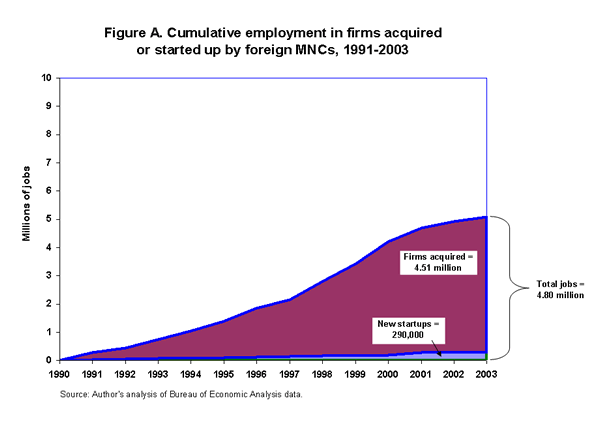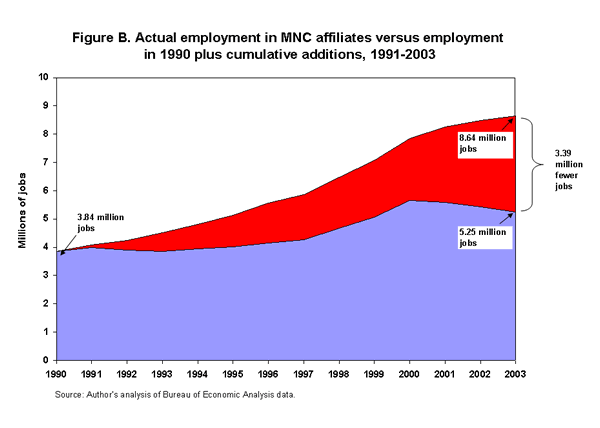See Snapshots Archive.
Snapshot for April 5, 2006.
“Insourcing” is not creating jobs in the U.S. economy
Dubai Ports World’s failed attempt to take control of a company that manages terminals at major U.S. ports has renewed debate about the benefits of “insourcing,” the shorthand for the notion that foreign companies that increase their investment in the United States are creating employment here. President Bush sounded this theme on a recent trip to a John Deere-Hitachi joint venture plant in North Carolina, and officials responded warmly to the announcement that a new Korean auto assembly plant—Kia Motors—will be built in Georgia. Treasury Secretary John Snow, visiting a plant purchased by Volvo in 1999, recently said, “We know that investment in America lies at the heart of creating good jobs…Indeed, 5.3 million U.S. workers alone are directly employed by U.S. affiliates of international companies.”1
But do we really know this? An examination of annual data collected by the Commerce Department on employment related to new foreign investment in the United States casts a different light on the employment benefits conferred by these deals. The acquisitions of ongoing U.S firms—not new startups—account for the vast majority of employment associated with new investments by foreign companies. And these investments, as a whole, have not been adding jobs over the past 12 years.
Some investments, such as the Honda auto plants built in Ohio over the past decade, have led to increased employment as they grew, but this is the exception rather than the rule. Some jobs were eliminated as imports were substituted for domestic production while others were lost through corporate reorganizations.
Acquisitions such as Daimler’s purchase of Chrysler in 1998 and Chinese computer maker Lenovo’s purchase of IBM’s PC business in 2004 were simple changes in ownership between domestic and foreign investors, and were not done to create new production facilities in the United States.
In the Commerce Department’s data, which distinguishes between acquisitions and start-ups, the true picture emerges. In 1990, U.S. affiliates of foreign multinational corporations (MNCs) employed 3.84 million workers. Between 1991 and 2003, foreign MNCs acquired firms employing 4.51 million workers (Figure A). Over that same 12 years, only 290,000 workers were employed in foreign-owned startups in the United States, or 24,000 jobs per year. Thus, foreign MNCs added or acquired firms employing 4.80 million workers over this period. If not for layoffs and the sale of some parts of these firms back to U.S. owners, total employment in these firms would have been 8.64 million jobs (including the 3.84 million workers they employed in 1990 plus the 4.80 million hired or acquired), as shown in Figure B. However, in 2003, these firms actually employed just 5.25 million workers. Thus, although total employment in foreign-owned firms increased in this period from 3.84 to 5.25 million jobs, 3.39 million jobs in these firms were either eliminated or divested to domestic owners in this period relative to potential employment of 8.64 million jobs shown in Figure B. Just because foreign companies are employing millions of Americans does not mean that those companies have created more jobs in the United States.


Notes:
1. U.S. Department of Treasury, press release. March 23, 2006. See http://www.treas.gov/press/releases/js4133.htm.
This week’s Snapshot was written by EPI economist Robert E. Scott.
